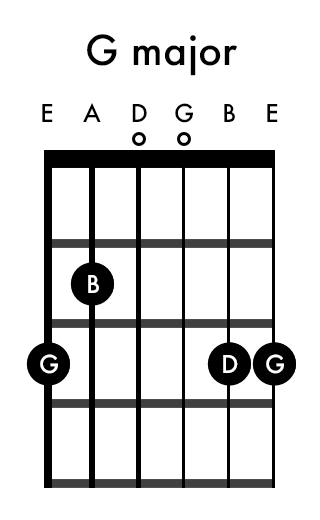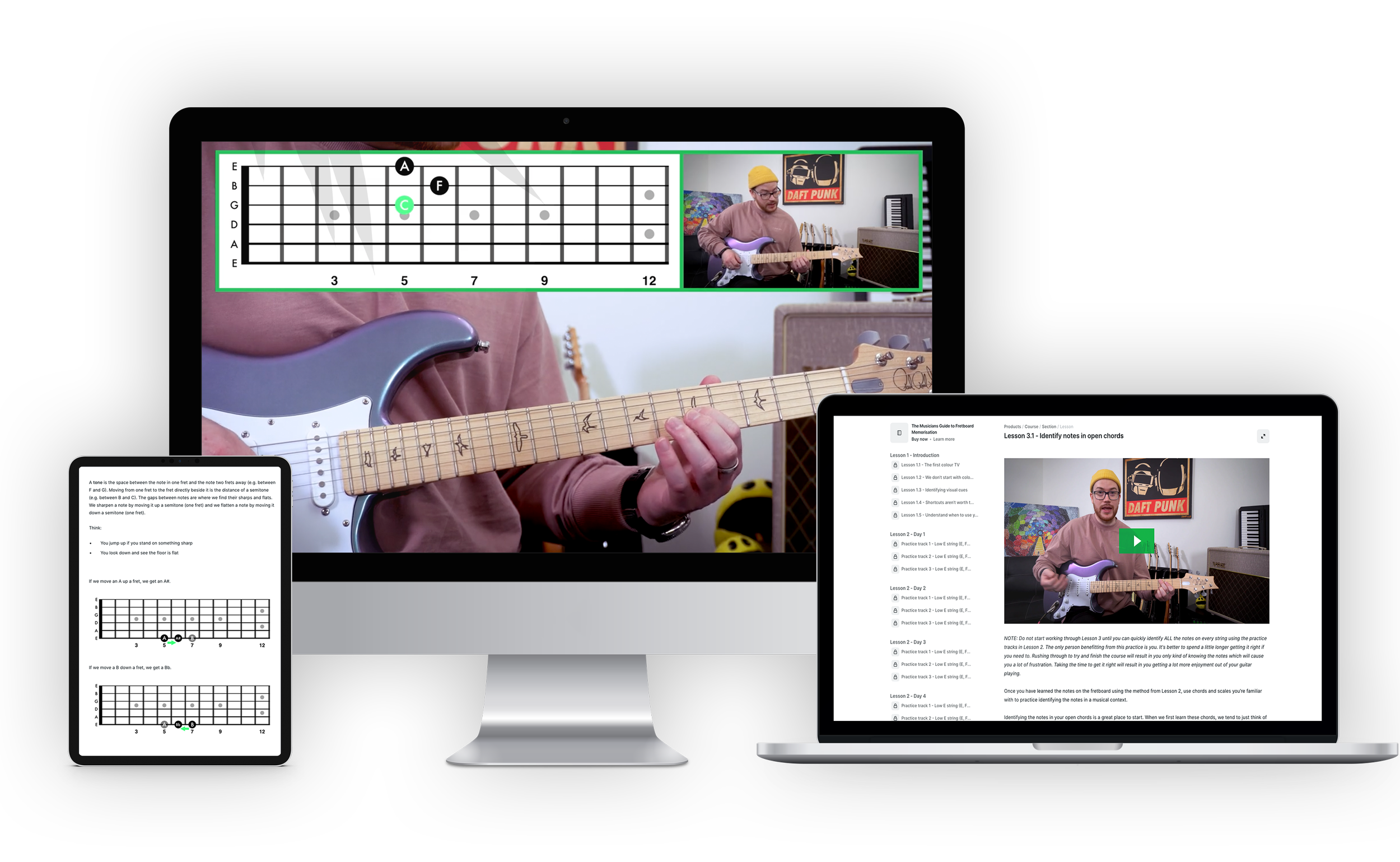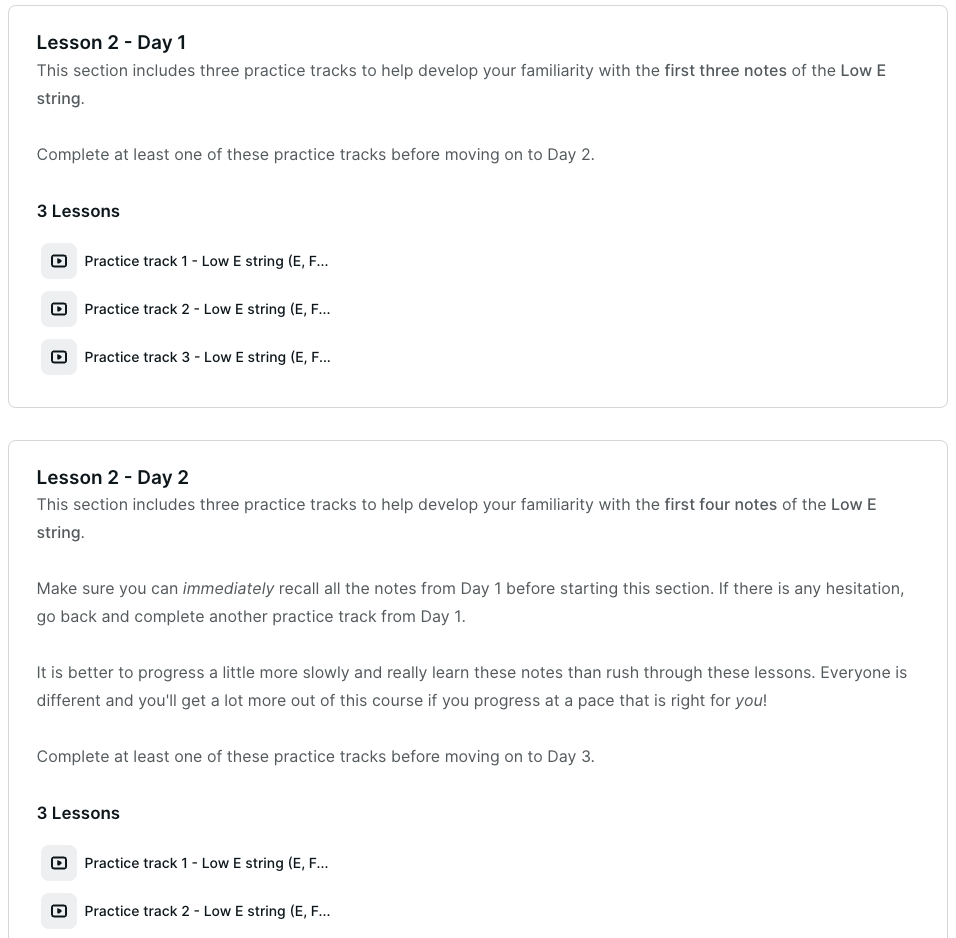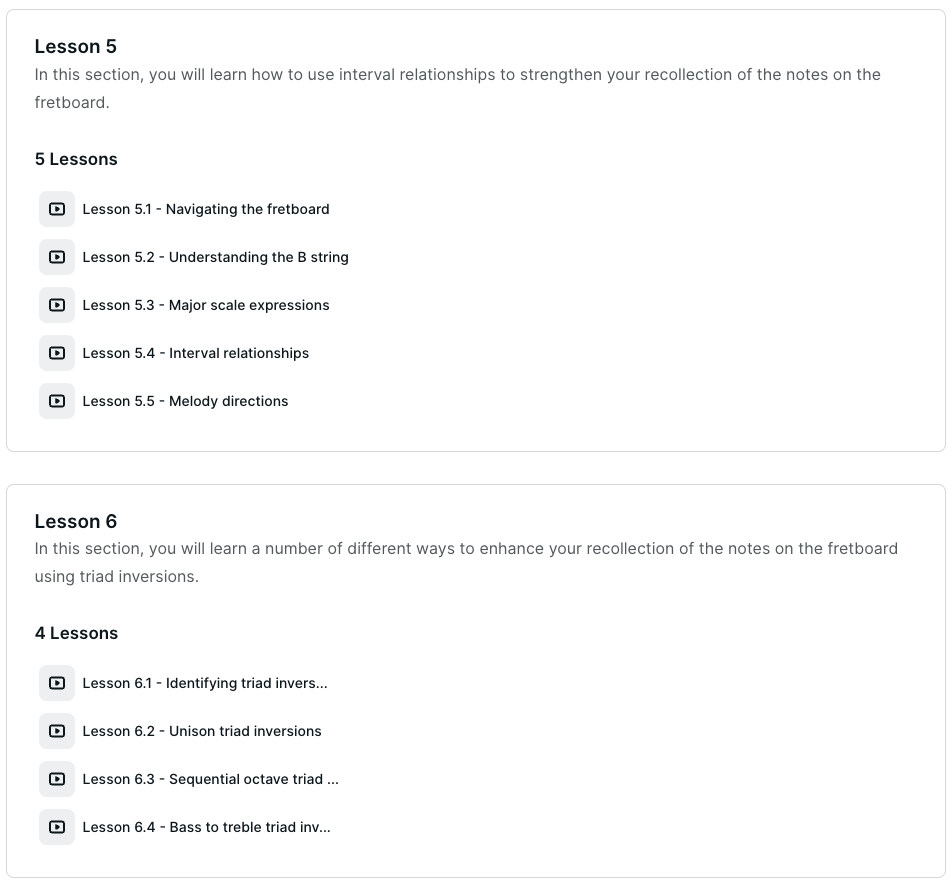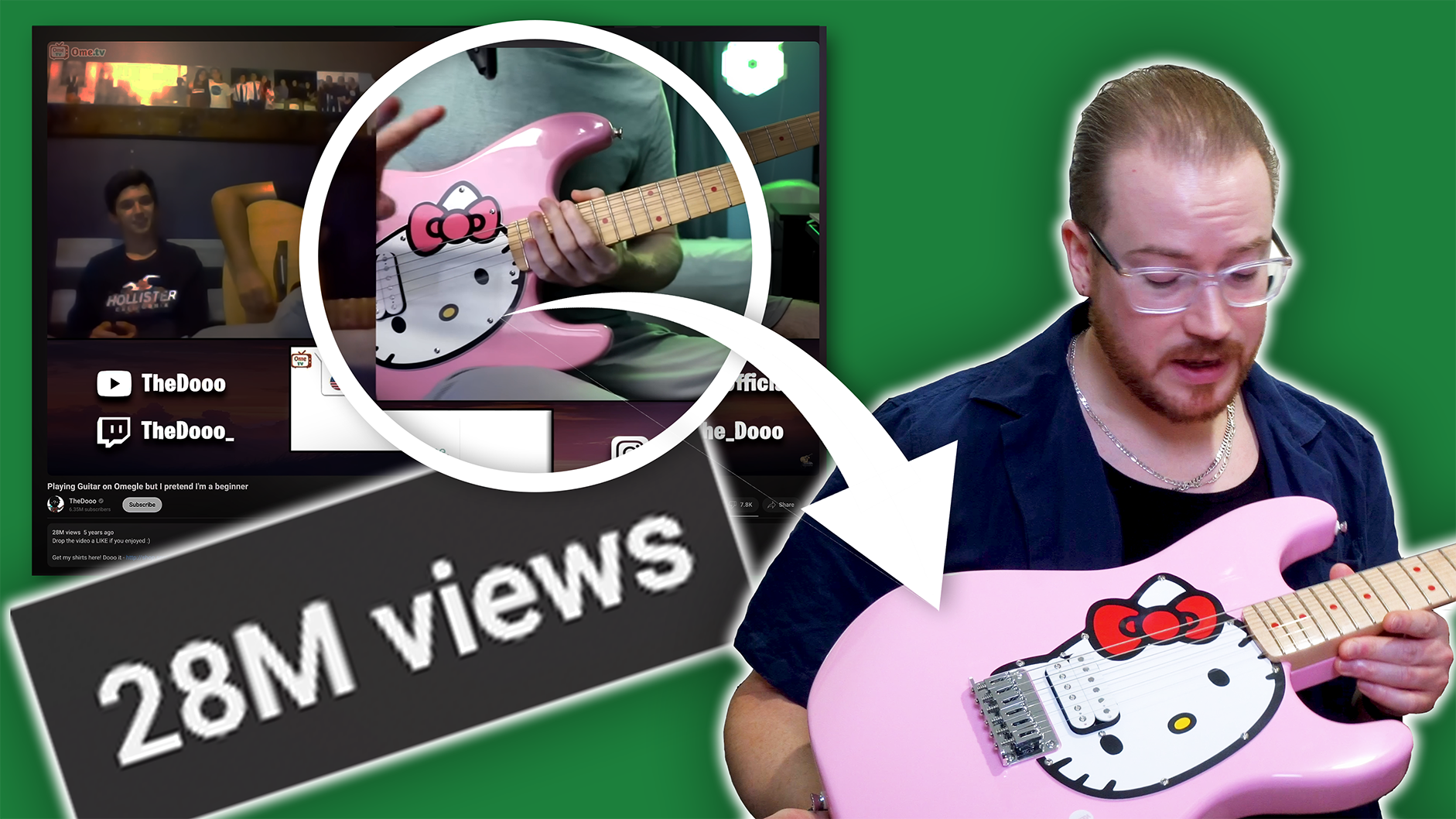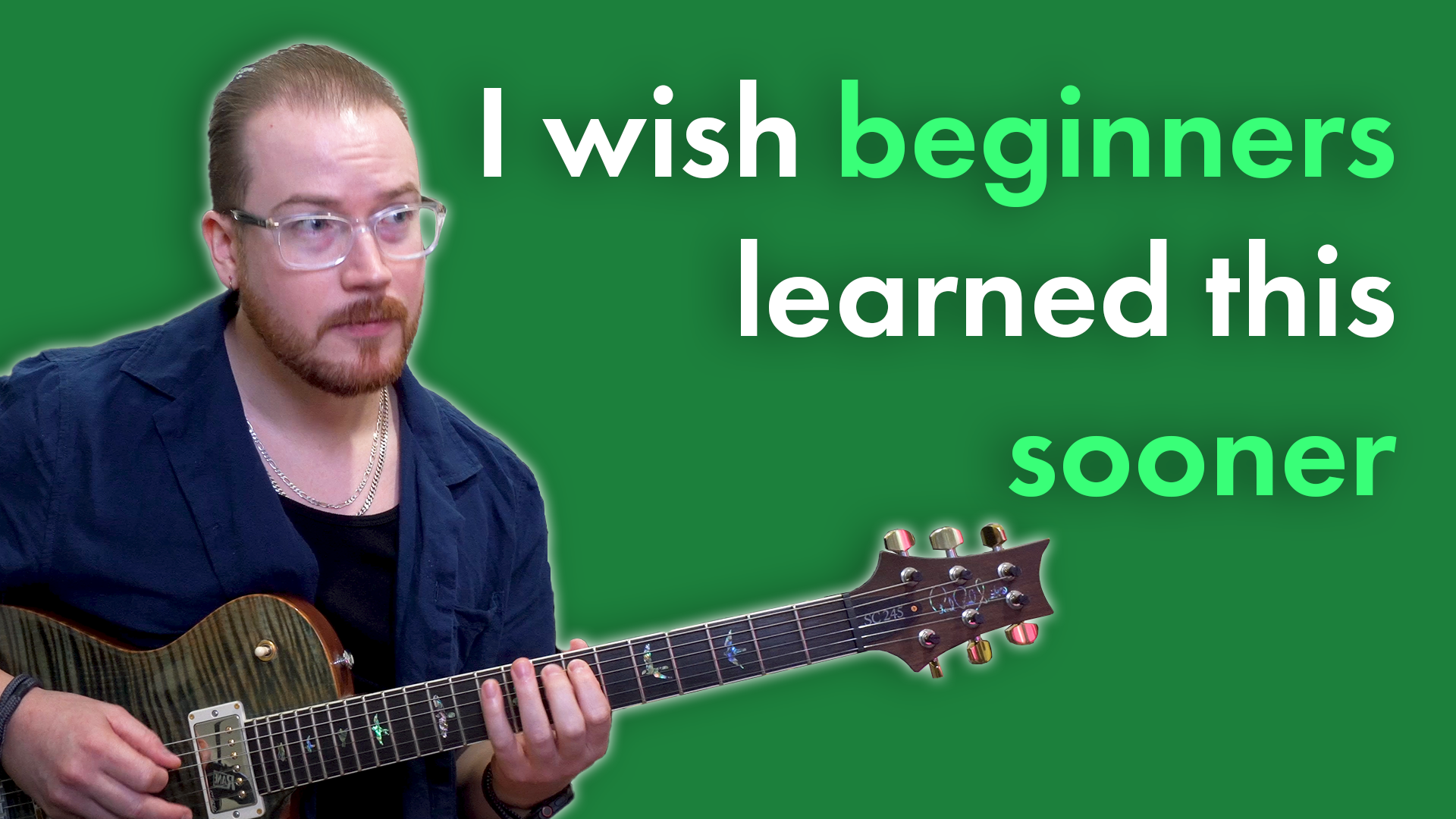The most effective way to memorise notes on the guitar fretboard
Over the years I’ve helped many students learn the notes on the fretboard with a simple and effective strategy that has them familiar with the entire fretboard in a minimum of 25 days.
For some students, it takes a little longer. But that’s okay. The point is to master the notes, not try and get through the exercises as quickly as possible.
Remember, you’re not competing with anybody. You’re doing this to increase your personal enjoyment of playing the guitar.
In this lesson, I’m going to explain why it’s important that we know the notes on the fretboard, I’m going to give you the simple and effective strategy I’ve used successfully with students for years, and I’m going to let you know about the some of the popular approaches a lot of guitar players seem to use and why you’re actually going to want to avoid them.
If you like the ideas I talk about in this lesson, you might enjoy The Musicians Guide to Fretboard Memorisation. It’s a course I created with step-by-step instruction and daily practice tracks to help you master the process of learning the notes.
I’ll tell you a little more about that at the end.
Why you need to know the notes on the fretboard
Not knowing the notes on the fretboard is like watching a movie in black in white. You understand the story - you can still see what’s going on. But seeing things in colour unlocks another whole dimension of understanding.
You might hear some people online talking about how you don’t need to know the notes on the fretboard. They’ll talk about how you can do everything by learning shapes and understanding scale degrees.
You can do that. But that’s like watching a movie in black a white. The people who are suggesting you do this aren’t recommending it because it is easier.
They are telling you to do this because they don’t know the notes on the fretboard themselves. Perhaps they’ve tried to learn them, but they have never got to the point where they are fluent.
They have only ever been able to recognise the notes by working them out.
You don’t need to know the notes on the fretboard to enjoy playing the guitar.
But no one who actually knows them fluently is going to suggest you shouldn’t bother learning them if you’re interested.
The level of freedom you’ll get from knowing the notes on the fretboard will make everything you do on the guitar so much easier.
It will feel like you’re supercharging your guitar playing.
It’s hard to articulate this experience exactly until you’ve done it, but here’s an example:
Look around your room. Can you see every colour? I’m sure you’re able to name them with zero hesitation if required. But you’re not looking around the room naming them in real-time!
This is what it’s like to be fluent with the notes on the fretboard. You’re not actively naming or recognising every note you play. We’re often playing too fast for that! However, when we’re fluent, we can recognise any note on the fretboard with zero hesitation. Just like when you name colours.
When you name colours, you don’t have to figure them out. You don’t look at the colour you’re trying to recognise and think, well, it’s not black. Is it a primary colour? You don’t do that. You look at the colour and just know.
This isn’t how we learn the alphabet. The alphabet is a sequence and we don’t ever use it outside of that sequence. It’s hard to recite backwards, it’s probably impossible to recite only saying every third letter, and if I ask you what comes before ‘q’? You’ll probably start singing the alphabet song in your head.
We learn and use the alphabet in a sequence, and it’s really easy to subconsciously adopt this approach when it comes to learning the notes on the fretboard because they are letters after all.
However, we want to learn the notes on the fretboard the same way we learn colours. We want to see them and just know.
Knowing the notes on the fretboard isn’t a substitute for being able to recognise scale degrees. We want to be able to do both.
Knowing the fretboard prevents you from playing the wrong note
Knowing the notes on the fretboard will allow you to do things like superimposing an Em triad over a C while being aware of the scale degrees as they relate to the Em chord or the newly created Cmaj7 chord simultaneously. It will make learning chords and riffs move effective as you’ll have another data point to associate with what you’re doing. And, it will prevent you from playing the wrong notes meaning you can learn scales and chords far more effectively.
To understand how that works, let’s think about the piano for a second. The piano is an instrument that has very obvious white notes and very obvious black notes. If you’re playing in the key of C, you should only be playing the white notes. That means avoiding the black notes. You can easily see if you’re playing the wrong note because it’s the wrong colour.
Now, the frets on the guitar aren’t so obviously different. In fact, every fret looks the same.
However, if you’ve taken the time to learn the notes on the fretboard fluently as we talked about, then we’re able to recognise every single note accurately in real-time. This means that when we’re learning a new chord or scale with an obscure fingering, we’re not relying on our ability to remember movements or recall a random pattern of dots on the fretboard. We look at the fretboard and can quickly and effectively target the notes we want to play. As we do this, we’re integrating our intellectual and physical understandings and improving our ability to memorise the concept overall.
Don’t use hacks to learn the fretboard faster
When you decide to learn the notes on the fretboard, it can be very tempting to use one of the common hacks that many guitar players use to “speed up the process”. But what might shave a couple of weeks off your initial learning of the notes, will ultimately cause you a lot of pain in the long run.
I was guilty of this myself. When I was first learning the guitar I learned the notes on the E and A strings and then used octave patterns to develop familiarity with the notes on the rest of the strings.
Here’s why that isn’t a good idea:
If you learn the notes using octave patterns, your brain will rely on that sequence to identify them. You’ll get quick at moving through that pattern. But you’ll still be moving through the pattern and that’s a problem. That takes mental effort and it takes time. It took me a long time to retrain my brain so I didn’t default to that pattern when I was trying to recognise a note. Don’t put yourself through that. Take slightly longer initially and develop fluency to recognise each note for what it is.
The ironic thing is that later on the octave pattern (and every other interval) becomes a fantastic tool to strengthen our knowledge of the notes on the fretboard in a very musical way. However, the distinction is at this point we are using them to enhance our knowledge, not establish it in the first place.
This is the process we want to use to learn the notes randomly:
Start with three notes on the Low E string (E, F, G)
Randomly call out one of these three notes and play it as quickly as you can (AFTER you call it out, not at the same time)
Do this for 60 seconds
On Day 2, check that you know the first three notes with NO HESITATION (if there is ANY hesitation spend another day on the first three notes)
If there is no hesitation, add the note A on the Low E string
Randomly call out one of these four notes (E, F, G, A) and play it as quickly as you can (AFTER you call it out, not at the same time)
Do this for 60 seconds
Repeat this process adding ONE new note every day if you can play the previous notes with NO HESITATION
Do this for all strings
It is extremely important that you trust the process.
This strategy for learning the notes will work extremely effectively if you make sure that there is absolutely no hesitation in your recognition of the previous day's notes before adding a new one.
Remember, you aren’t trying to prove anything to anyone.
This is about you learning the notes.
Do it carefully; do it right.
Pay attention to what you see
One of the frustrating things about learning the notes on the fretboard is the fact that every fret looks the same, right?
Well, actually no.
Every fret does not look the same.
The guitar has fret markers laid out on specific strings. And, obviously, each string is in a different place.
Use this to your advantage when you’re learning the notes on the fretboard - make a point of notice where each note is exactly.
The A on the Low E string is on the fifth fret. That’s usually the second dot. It’s also pretty much in the middle of the fretboard. It’s on the Low E string, which is at the edge.
Fig. 1: The ‘A’ note on the low E string.
The F on the A string is in the eighth fret. That’s the empty fret just beside the third dot (on the seventh fret). It’s a little further up the neck from the middle and it’s on the A string, which is the second from the edge.
Fig. 2: The ‘F’ note on the A string.
Notice everything you can. The more data points you can connect to your memory of the note the easier it will be to recall. This process is an example of how we might engage our intellectual understanding while we are learning the notes on the fretboard.
Keep recognising the notes on the fretboard as part of your guitar practice
Once you’ve learned the notes on the fretboard everywhere with no hesitation, you’ll want to continue to strengthen your knowledge in a musical way. While learning the notes randomly is still the best way to develop familiarity with them, we also want to practice them with some other exercises.
Because of the way we develop muscle memory, we can still end up becoming too reliant on recognising notes randomly in the context of a single string.
Here are some practice drills that you can use to break out of this structure and continue to improve your knowledge of the notes across the fretboard in a musical way:
Identify notes horizontally and vertically
Pick a note and practice identifying it horizontally across the fretboard. This is what it would look like if we identified every C horizontally across the fretboard.
Fig. 3: Identifying ‘C’ horizontally across the fretboard.
Pick a note and practice identifying it vertically across the fretboard. This is what it would look like if we identified every C horizontally across the fretboard.
Fig. 4: Identifying C vertically across the fretboard.
Identify notes in chord shapes
Identifying the notes in chord shapes is a great way to start incorporating some musicality while you are learning the notes on the fretboard.
You can do this with literally any chord shape, but if you haven’t done this before, try starting with:
Open chords
Bar chords
Three-string triad shapes
When you’re identifying the notes in chord shapes you also want to make a point of identifying the scale degrees each of those notes are within a chord. This will help you start developing your understanding of interval relationships within chords.
Fig. 5: Open G major chord (showing fingering).
Fig. 6: Open G major chord (showing note names).
Identify notes as intervals
At the start of this lesson, we said we don’t want to use the octave interval as a way to work out notes on the fretboard. However, after we’ve got the notes down, intervals become a really valuable tool to continue to improve our recognition of the notes on the fretboard in a musical way.
When we recognise the pair of notes in an interval, we’re doing more than just improving our recollection of the notes on the fretboard. We’re also familiarising ourselves with the scale degrees and relationships between notes across the fretboard.
Music is made up of intervals. Harmonic intervals form chords, and melodic intervals form melodies. The more effectively we are able to understand and recognise these intervals, the more effectively we’ll be able to do everything on the instrument.
Fig. 7: A fifth interval expressed in both the right and left expression.
These are by no means the only ways you can continue to improve your knowledge of the notes on the fretboard. Come up with some of your own drills and let me know what they are in the comments!
The Musicians Guide to Fretboard Memorisation
If you carefully follow the strategy I’ve outlined in this lesson and practice every day, you’ll have mastered the notes on the fretboard in one to three months. If you’re thinking about learning the notes on the fretboard, you probably want to enjoy playing the guitar for the rest of your life. A few months is nothing to develop a skill that is going to maximise your enjoyment of every other aspect of your guitar playing.
If you feel like you don’t have the knowledge or motivation to do this on your own, click the button below and I’ll walk through it with you step-by-step.
The Musicians Guide to Fretboard Memorisation is designed to take you through the entire process of memorising the notes on the fretboard in the most effective and most musical way possible.
After going through the course, you’ll probably find your general musicianship and chord knowledge have also improved in addition to having mastered the notes on the fretboard.
We want to maximise our practice and make it as effective as possible by making sure that the exercises we are working on hit things from multiple angles.
The Musicians Guide to Fretboard Memorisation does exactly that.
The course is divided into three sections.
We’ll start off by going over the ‘why’ we actually want to learn the notes on the fretboard. How is it going to help our playing? And, how do we want to approach it in order to make the process as effective as possible?
Fig. 8: Lesson 1 from The Musicians Guide to Fretboard Memorisation.
The second section will take you through 25 days of practice tracks that will allow you to learn the notes randomly as we talked about in this video. This won’t take you any more than 10 minutes a day.
Fig. 9: Lesson 2 from The Musicians Guide to Fretboard Memorisation.
In the third section, we’ll go over a number of different exercises we can use to continue to strengthen our knowledge of the notes on the fretboard in a musical way.
Fig. 10: Lesson 5 and 6 from The Musicians Guide to Fretboard Memorisation.
The cool thing about these exercises is that they are more than some tools to help you improve your ability to recognise notes on the fretboard. You’ll find that they exemplify an approach to developing awareness of what you’re doing on the guitar. If you think of it this way you’ll find that literally, everything you do starts to become a tool to strengthen your knowledge of the guitar fretboard and how music works!
Click the link below if you want to try The Musicians Guide to Fretboard Memorisation. If you don’t like it, you can cancel for a full refund!






